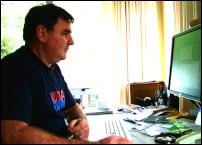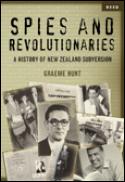Graeme Hunt's Book on New Zealand Spies and Revolutionaries – Chapter Ten: Friendly fire
Scoop is serializing the first 1000 words of each chapter of author Graeme Hunt's latest book: Spies And Revolutionaries – A History of New Zealand Subversion. Click here for Chapter Ten: Friendly fire
 The history of New Zealand's intelligence agencies and
those it has spied on have been laid bare in a book by
Auckland-based journalist, author, and historian Graeme
Hunt.
The history of New Zealand's intelligence agencies and
those it has spied on have been laid bare in a book by
Auckland-based journalist, author, and historian Graeme
Hunt.
Spies And Revolutionaries – A History of New Zealand Subversion details how several prominent New Zealanders, all of whom are dead, spied for the former Soviet Union during the Cold War. Accusations and suspicions are laid bare before files and information that has never before been made public. This book will clearly recharge debate as to whether Dr Bill Sutch, diplomat Paddy Costello, and public servant Ian Milner were spies acting against New Zealand's national interest.
 From their earliest days in New Zealand, the left ––
particularly the communists –– sought to awaken New
Zealanders to areas of international strife and challenge
traditional thinking. Even before the Russian Revolution,
many on Labour’s left had embraced Sinn Féin’s demand
for a republican Ireland. Throughout the 1920s, the
Communist Party of New Zealand and communist-led unions,
such as the United Mineworkers and the Federated Seamen’s
Union, devoted considerable time and energy to debating
international issues well beyond industrial solidarity with
unions overseas. New Zealand’s handling of the Mau
insurgency in Western Samoa in 1928 came in for particular
criticism.
From their earliest days in New Zealand, the left ––
particularly the communists –– sought to awaken New
Zealanders to areas of international strife and challenge
traditional thinking. Even before the Russian Revolution,
many on Labour’s left had embraced Sinn Féin’s demand
for a republican Ireland. Throughout the 1920s, the
Communist Party of New Zealand and communist-led unions,
such as the United Mineworkers and the Federated Seamen’s
Union, devoted considerable time and energy to debating
international issues well beyond industrial solidarity with
unions overseas. New Zealand’s handling of the Mau
insurgency in Western Samoa in 1928 came in for particular
criticism.
Throughout the 1930s, the rise of fascism in Europe, the Spanish Civil War and Japan’s aggression in China became the causes célèbres of the left. When the Soviet Union and Germany invaded Poland in 1939, the Communist Party stood firmly behind Moscow. But when Finland was invaded by Russia three months later, the Seamen’s Union, by now Trotskyist led, publicly attacked the ‘Soviet crime’ and expressed ‘profound sympathy with the people of Finland now suffering under a brutal aggression in pursuance of the policies of the Stalin–Hitler partnership’. Seamen’s leader F.P. Walsh even corresponded with the exiled Russian leader Leon Trotsky in Mexico.
After World War II the Cold War put the Communist Party of New Zealand, by now tilting towards China, at constant odds with the government. This was the case with New Zealand’s involvement in the Korean War and in the Malayan Emergency. But the left’s post-war cause célèbre, however, was the Vietnam War. New Zealand was a reluctant participant in the conflict, drawn in by its membership of the Anzus and Seato defence pacts, and it committed troops, all volunteers, under sufferance in 1964. Many ordinary New Zealanders, including the author’s parents who were anything but left wing, considered the government of South Vietnam corrupt and its democratic credentials highly questionable.
The left used the divisions the war created to attack American foreign policy, though the Communist Party of New Zealand, by now solidly in the Chinese camp, was no great admirer of the North Vietnamese regime. The high point of the anti-war campaign was the level of protest during the visit of US President Lyndon Johnson to Australia and New Zealand in October 1966.
The anti-war movement fostered by the Vietnam War was far more than a leftist rump. At its heart were students but there was also a strong middle-class liberal/intellectual element. Many of its members became prominent in the women’s, anti-nuclear and Maori protest movements and some, not least university political studies lecturer Helen Clark, made their careers in national politics. It is hardly surprising then that members of the anti-war movement, some of them ‘professional protesters’, would play a significant role in opposing the 1981 South African rugby tour of New Zealand.
A pointer to the style and scale of protests that might be expected when the Springboks arrived came from the Maori protest movement. This had grown significantly since 1971 when the radical Nga Tamatoa movement staged the first big protest to disrupt the Waitangi Day commemorations in the Bay of Islands. Later that year the Polynesian Panthers, a shadowy group based on the US Black Panthers, advocated the overthrow of the capitalist system.
In September and October 1975, 79-year-old Whina Cooper, a widely respected Maori elder, led a Maori land march –– the hikoi –– from Northland to Parliament. Although a dignified protest, the march spurred Maoridom’s militant wing into more serious direct action. That came on 5 January 1977 when protestors led by Joe Hawke (years later a Labour list MP) occupied Bastion Point in Auckland after the government announced a housing development on former Ngati Whatua reserve land overlooking the Waitemata Harbour.
Nearly 14 months later
the National government agreed to a revised plan for the use
and development of the land, including the return of nearly
12 ha to Ngati Whatua. National Prime Minister Rob Muldoon
considered the settlement generous, according to his
biographer Dr Barry Gustafson, but the protest continued. On
25 May 1978 some 600 police backed by the army cleared
the site, arresting 230 protestors in the process. That did
not end the dispute, which was resolved only when the Labour
government returned the disputed land with compensation to
Ngati Whatua in 1987 on the recommendation of the newly
created Waitangi Tribunal.
Bastion Point had demonstrated the power of direct action and tested the ability of authorities in a democracy to control spirited and sometimes violent dissent. The proposed South African rugby tour was to be the greatest test of all.
Opposition to sporting relations with apartheid South Africa went back more than a generation. In 1960, in the face of considerable domestic disquiet, Maori were left out of the All Black team to tour South Africa because of the South Africans’ ‘whites-only’ policy. This had happened on the 1928 and 1949 tours, though the Springboks had played against Maori teams or players on their 1921, 1937 and 1956 tours downunder and were well aware of New Zealanders’ sensitivities on the race issue.
The exclusion of Maori from All Black teams touring South Africa was not only an affront to New Zealand race relations but also its sovereignty, and the selection of a whites-only New Zealand team in 1960 was the last. Thereafter, ‘no Maoris, no tour’ was the order of the day. But that was only half the problem. South Africa was still selecting its sports teams on the basis of apartheid. The extent to which New Zealand could or should challenge South African domestic policy, as abhorrent as apartheid might seem to ordinary Kiwis, was still to be tested.
South Africa was a formidable rugby foe –– the only rugby-playing nation that held the edge over New Zealand –– and to end sporting relations was unthinkable to most sports-mad New Zealanders. That said, the pro-tour majority could not simply be dismissed as apologists for the South African regime. Sport had been independent of the state in New Zealand since the start of European settlement. It was mostly amateur and privately run and there was no mandate for governments to direct which teams New Zealand sportspeople should and should not play.
The late Labour prime minister, Norman Kirk, had not been forgiven by many in the rugby fraternity for ordering the ‘postponement’ of the South African rugby tour to New Zealand in 1973 in the face of threats of match disruption from anti-tour groups and a possible black African boycott of the Commonwealth Games in Christchurch the following year. This was contrary to a promise Kirk had made during the 1972 general election campaign.
In 1977, as the international pressure on South Africa grew, Commonwealth presidents and prime ministers agreed to discourage contact and competition between their sportsmen and sporting organisations, teams or individuals from South Africa. The agreement was reached unanimously at Gleneagles in Scotland during the Commonwealth Heads of Government Meeting. In New Zealand terms, this did not equate to a democratic government banning sporting contacts between the two countries.
See Also:
and Revolutionaries, Chapter Seven: Trinity's
traitor
& Revolutionaries – Chapter Six: Empire strike
Back
and Revolutionaries – Chapter Five: Red wreckers and
fellow travellers
and Revolutionaries – Chapter Four: Lenin's Lieutenants
and Revolutionaries – Chapter Three: Karl Marx's
legacy
Spies and Revolutionaries - Chapter Two: French, Russians
and Fenians
and Revolutionaries - Chapter One: Murder in a country
churchyard
Scoop is serializing the first 1000 words of each chapter of author Graeme Hunt's latest book: Spies And Revolutionaries – A History of New Zealand Subversion.
SRP: $29.99
ISBN:
9780790011400
340p, includes index, black and white
photos
Reed Publishing (NZ) Ltd www.reed.co.nz
Release: August 6 2007
For more, see… Reed Publishers, Spies And
Revolutionaries



 Eugene Doyle: The Fall Of Saigon 1975 - Fifty Years Of Repeating What Was Forgotten
Eugene Doyle: The Fall Of Saigon 1975 - Fifty Years Of Repeating What Was Forgotten Peter Dunne: Dunne's Weekly - Trump's Tariffs Still Pose Risks For New Zealand
Peter Dunne: Dunne's Weekly - Trump's Tariffs Still Pose Risks For New Zealand Keith Rankin: Barbecued Hamburgers And Churchill's Bestie
Keith Rankin: Barbecued Hamburgers And Churchill's Bestie Gordon Campbell: On Why The US Stands To Lose The Tariff Wars
Gordon Campbell: On Why The US Stands To Lose The Tariff Wars Eugene Doyle: Before It’s Too Late - Reimagine New Zealand’s Military Future
Eugene Doyle: Before It’s Too Late - Reimagine New Zealand’s Military Future  Binoy Kampmark: Gender Stunts In Space - Blue Origin’s Female Celebrity Envoys
Binoy Kampmark: Gender Stunts In Space - Blue Origin’s Female Celebrity Envoys